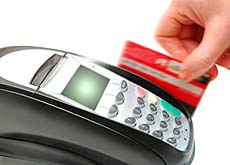 Here Is How The Credit Card System Works
Here Is How The Credit Card System Works
Insert Chip, Swipe Or Enter The Card Number
The business (merchant) charges a credit card using a terminal, software, and/or browser. The customer's credit card is either present at the sale (retail) or not present (internet, mail-order or telephone-order). Your costs are based on risk of fraud...see below.
Card Gets Authorized And Decisioned
The credit card info travels through a processing network to validate the card and availability of funds. This first step is an authorization. The second step, that happens instantly, is a settlement of that authorization. The processor handles debiting or crediting that card on the backend.
You Confirm Today's Items
The merchant commits that day's batch of transactions after confirming those transactions as correct. This is called a settlement which tells the processor to debit and credit both banks the proper amount. This electronic request gets staged by the banks and usually completes the funds transfer in about 24 hours on business days.
 Monthly Fees Get Paid
Monthly Fees Get Paid
At the end of the month, the processor tallies up all of the fees, automatically debits your checking account for these fees, and sends you a statement. If your processor is taking out their fees on each daily deposit, call us as we only charge fees at the end of the month.
How & Why Fees Are Charged:
- There are three entities involved in the credit card processing flow. The credit card issuer (usually a bank), the card type association (ie. Visa, Mastercard, Discover, Amex), and the processor.
- All processors pay the same exact "costs" for each card style and type. These publically viewable costs are called Interchange and can be found at Visa.com, MasterCard.com, and Discover.com. The only thing that you can control is what you are willing to pay beyond the Interchange costs. Note that sometimes American Express gets processed through your Visa/MasterCard network as an Authorization fee...you will receive a separate American Express statement and they charge their own fees of 2.89% plus $0.10 for swiped, or 3.19% plus $0.20 for key-entered items. Their new OptBlue program allows the processor to run the Amex transactions on behalf of Amex and those transactions are bundled into your same Visa-Mastercard-Discover deposits, and are also listed on your same statement. OptBlue is only for merchants doing less than $1M per year in Amex, and is usually beneficial with lower rates for certain industry types and certain ticket amounts.
- Fees are all based on risk of loss and charge-offs, and on associated rewards offered by that card type such as air miles. Debit cards are the least risky because the money comes from a checking account vs. a revolving line of credit. Corporate cards are the most expensive due to corporate rewards, insurance, risk of fraud, taxes, etc. Most cards have a raw cost of 1% to 2.95%, plus association fees and processor fees.
- Almost ALL of the fee money goes to the credit card issuer. This is why many businesses are offering their own company branded cards. This is how an airline is able to give you a free flight right away...it's because they are making $250 with you running about $10,000 on your card. Visa, Mastercard, and Discover take a tiny fixed slice of every transaction (0.11% or 0.0011) which pays for branding, customer benefits, security standards, etc. The processor has many internal fees that allow the card to pass through the system and to support impeccable and precise transactional historical storage, reporting, and other value-added services such as online reporting, next day funding, etc.
- Example Transaction:
1. You swipe/chip a card-present Chase Visa Credit Card for $100.00.
2. The processor has a cost called an Authorization fee of about $0.10
3. Chase makes 1.54% plus $0.10 as a per-item settlement fee
4. Visa takes their fixed 0.11% which equals $0.11 (11 cents)
5. The processor (ie. TSYS, Global Payments, Elavon, FirstData) has a cost of maybe 0.25% for this particular merchant totalling $0.25 (25 cents)
TOTAL COST ON YOUR STATEMENT:
$2.10 (which results in 2.10% on average by dividing $2.10/$100)
On average after a variety of different card types, expect a total true-cost of 1.6% to 2.1% for retail locations where you swipe. For internet key-entered businesses, expect a total true-cost of about 2.2% to 2.6%.
Never compare loss-leader rate teasers! Much like a mortgage, there are a lot of ways to tweak numbers on the back-end and you can be assured that banks
are rarely offering you the best rates available.
- Budget about 2% to 2.5% of credit card sales as your TOTAL card processing fees. Since debits are less risk, they are less expensive at 0.05% + $0.22 for Visa which equates to lower total costs for these transactions. This $100 debit would have been about 0.75% instead of the 2.10% percent from the example above.
- Accepting credit cards at your business is a privilege for business owners who have good credit. The risk of your card processing company comes into play if the business cannot pay its fees or chargebacks that are due to the processor. A merchant can declare bankruptcy, close the account and the processor is left eating those losses. Technically, a merchant account is equivalent to a commercial line of credit to where the bank is fronting you money in hopes that everything gets paid back correctly.
|

 Here Is How The Credit Card System Works
Here Is How The Credit Card System Works Monthly Fees Get Paid
Monthly Fees Get Paid